Deafblind in Japan: My 5 Week Journey
Julie Ferguson is registered deaf and blind. She also speaks five languages. Julie shared her story with us before here on the blog as well as in the Fluent in 3 Months book. This is the inspirational story of her recent visit to Japan.
Deafblind in Japan
I'm nightblind. I'm standing in Akihabara, Tokyo, in the dark. And I'm lost.
Do I:
- A: keep walking until I find a train station or taxi,
- B: burst into tears in the middle of the pavement,
- C: ask that Japanese man over there for directions, in Japanese?
I choose option C. And I succeed.
Back in June 2015, I was registered blind due to worsening retinitis pigmentosa. What this means is that my tunnel vision is so bad now that I have less than 10 degrees of useful vision remaining. Increasing difficulty keeping up with my full-time job as a science teacher had made me suspect that it was going to be sooner rather than later. Even so, I wasn't ready for it yet.
My five-week trip to Japan had been booked and paid for a couple of months before this. Planning my trip was really exciting because I had been learning Japanese for a while, and my best friend was coming with me for the first week. After she left, I was going to do a two-week language course. Given my horrible vision and deafness, I was going to have to be extremely well prepared for Japan.
Things I Needed in Japan (in Addition to the Usual Stuff)
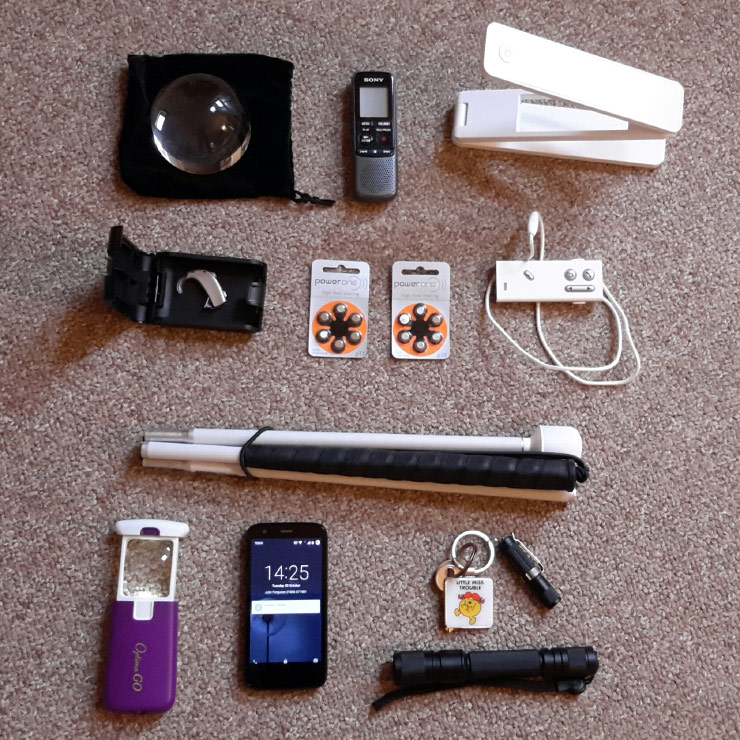
- my white cane
- a spare white cane
- my hearing aids
- a spare hearing aid for my “good” ear
- about 40 batteries for my hearings aids even though I probably only needed 6, maximum
- a radio aid that links to my hearing aids by bluetooth so I can use my mobile phone (the radio aid can also be a microphone at short range)
- my mobile phone with a Japanese- English dictionary app
- a magnifying glass for reading kanji from my Japanese textbook
- a magnifying glass with built-in light for reading at night e.g. bus timetables
- a portable desk lamp for classroom use or in hotels
- two torches (a small one on my key-ring and a larger one in my bag)
- an mp3 recorder for recording and replaying lessons
- my best friend, for calm and serenity
What Am I Doing Here?! (Tokyo)
We started in Tokyo, and stayed in the Asakusa part of town. Our hotel was right around the corner from Sensoo Ji, a temple dedicated to Kannon. We explored a little then went looking for food. My friend doesn’t speak Japanese other than “watashi wa vegetarian”, and polite phrases, so I was in charge of talking to people. Ordering food took a very similar pattern for the next eight days:
Friend (in Japanese): I am vegetarian.
Server: Okay!
Friend (pointing at food in menu): Vegetarian?
Server: Yes
… food comes to the table, we look at it and realise there are pieces of bacon in it…
Me (in Japanese): This has meat in it. My friend does not eat meat.
Server: Oh, there is nothing she can eat here.
We learned to stop saying “vegetarian”, and switched to “my friend does not eat meat or fish. What can she eat here?” This worked most of the time, though some bacon sometimes still sneaked in there. My proudest food moment was when I managed to ask in Japanese for bacon not to be put in her sandwich while it was being made.
I found the subway system in Tokyo very difficult to deal with. Each line would have two platforms, one for each direction. Although most signs were in English as well as Japanese, I couldn’t see any signs saying which platform to use. Luckily we were able to ask railway attendants for help, and they would show us to the right platform, put us on, and phone ahead to the station we were getting off at. At our destination, there would be an attendant waiting to help us off, and they would ask where we were going to so that they could show us the right exit as well. The railway attendants were amazing and really helped my stress levels to drop a little.
Tokyo was, for me, really confusing and overwhelming. I didn’t feel comfortable there, and my Japanese was not as good as I had expected it to be. I was struggling to follow what people were saying, and my friend told me that I was almost whispering when I spoke Japanese which probably didn’t help!
Ah, This is Better (Kyoto)
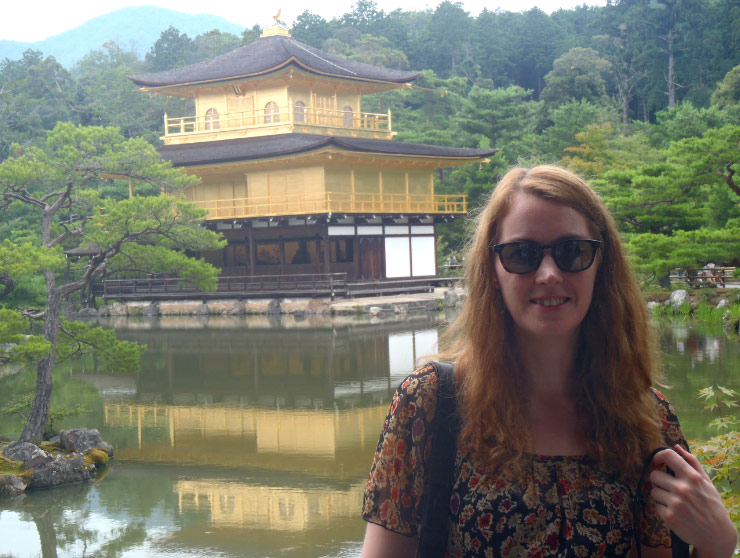
After four days in Tokyo, we went to Kyoto by shinkansen (high speed railway) and we were lucky enough to get a glimpse of Mount Fuji on the way. We had help from the railway attendants again and made it to our hotel safely.
Our first port of call was Nishiki Market, because I’m a bit of a foodie. It was heaven walking along the market, checking out all the different food, and the other shops. When we saw a crockery shop, we had to stop and look at the lovely cups. I’m also a tea geek, so looking at the variety of tea cups was great. I ended up buying one, and told the shopkeeper how beautiful I thought it was, in Japanese. He looked really happy, so I think I managed to say it right!
While we we were travelling in Japan, we were using manaca travel cards which you swipe at train stations and on some buses. We had to put more money on the cards in Kyoto, and found the machine to do so. It took us a while to figure out how to add more money, and it wasn’t until afterwards that we realised that there was an English language option on the machine… At least it meant that we did it in Japanese! Because of my tunnel vision, I miss details like this all the time and it takes me longer to figure things out. In Scotland, I get a lot of people assuming I need help, whereas in Japan, people waited for me to ask which I liked a lot.
Something I noticed in Kyoto was that I always knew when I was near a temple, because I could smell the incense on the wind. One temple we visited was Sanjuusangen doo. We had to take off our shoes, and an assistant also wiped the tip of my white cane to ensure cleanliness. At another temple, in Nara, we bought incense sticks for my friend to take home but one broke. An obaa-san insisted on her getting a new stick, then she took us over to light the broken incense and showed us how to pray properly. She was so cheerful and spoke to us in a mixture of Japanese and English. It was hard to follow her accent, but miming definitely worked.
Time to Get Serious (Fukuoka)
My friend left for Scotland and now it was time for me to travel on to Fukuoka. At Kyoto Station, I requested assistance, being very nervous about the sheer size of the station and the importance of getting the right train. My main worry was the 20 minutes in Shin Osaka that I had for changing trains, so the assistance was a big help.
At Hakata Station, I took a taxi to my short-term apartment. Something I found tricky in Japan was the taxis. In Scotland, if I’m travelling alone, I just get into the front seat where I can see the driver to lip-read. In Japan, I had to get into the back seat so I couldn’t lip-read. Most of my taxi journeys consisted of.
Me: Here please (pass address written in Japanese)
Driver: (stream of fast sounds)
Me: Sorry, one more time please.
Driver: (stream of fast sounds)
Me: Sorry, my Japanese is bad and I’m deaf.
Driver: (silence until destination)
Once I settled into my apartment, I made a list of things I needed for groceries. I had made the list in English, then thought to write the names in Japanese in kana. This ended up being really useful in the Family Mart, because the shop assistant noticed my list then showed me to all the things I needed. The next day, I went shopping for anti-histamines (insect bites!) and an electric toothbrush to replace my broken one. The department store was unbelievably huge and I found the pharmacy by sheer accident. I had to ask where the toothbrushes were and a very helpful shop assistant who spoke no English helped me decide which one to buy. After 24 hours in Fukuoka, I was speaking more Japanese than I had in the past eight days!
It was in Fukuoka that I studied at the Genki JACS school. It made my brain hurt! I spent two weeks at this school and I really learned a lot, but suddenly having to listen and speak in Japanese for more than 20 hours a week with no escape was really tough. Given that I mostly studied reading and writing before going to Japan, I needed this. During class, we drilled questions and responses until they came out sounding more natural, as well as learning to use grammar faster. To start with, the teachers were unsure of how to help me in class but I explained that as long as I could ask them to repeat things or write them for me, I would be fine. I used my magnifier for the textbook (kanji details and furigana!), and recorded all the lessons so that I could play them back for more practice. They also asked others in the group questions before me so that I had a chance to figure out what was going on. I knew I was slowly improving because my stress levels were slowly decreasing each day.
Exploring around my neighbourhood, I found a Book Off. I really liked it there. The manga section was upstairs and I confess this freely: I have no idea how manga books are organised in a book shop. I just don’t get it. The manga I bought were found purely accidentally while browsing and trying to figure out the system. There was also a children’s section, and I hoovered up some interesting looking books there too, including one which I had to slowly sound out in katakana He Re N Ke Ra a. Huh? Heren Keraa? Oooh, Helen Kelaa. Yes, I had found a Japanese biography of one of my heroines, Helen Keller. Delighted!
On a day off, I went to see Fukuoka Castle and stopped for a tea break in a cafe afterwards. Boy, was I glad I had gone in! About 5 minutes after sitting down, the rain started to lash down then rumbling noises started. Hmm. Dictionary app out, ask the cafe woman if that was thunder, yes it was, look at my metal white cane, see lightning starting, check app again, ask cafe woman if I can stay until the thunderstorm’s done. She laughed and told me to stay, then asked where I was from. When I said Scotland, she told me that she had been to London and would like to go to Scotland one day. I had my app, she had her app, and we had a great time blethering about Scotland and Kyushu in a mixture of English and Japanese.
Before I left Fukuoka, I visited a department store. I was looking for some presents to take home with me when I saw a really cool cat apron. I couldn’t see any aprons other than the display one, so I mustered up my new and improved Japanese, asked a shop assistant if they had any more in stock and asked to buy the display one when they said it was the last one. I did it without too many long pauses, I was understood right away, and I got the outcome I wanted. Studying and practicing really does pay off.
It was the Best of Times, and the Worst of Times (Hiroshima)
Sometimes having tunnel vision leads to moments of unexpected drama. In Hiroshima, I was concentrating on finding my way to the Peace Park, and not bumping into people when I stopped and looked to my left. The Atomic Dome was just there and my heart gave an extra “thump”. Later, in the museum, I was surrounded by fellow Scottish accents, which sounded almost strange after two weeks of Japanese immersion. I had a piece of home with me, in a place which documented one of the most horrific acts humans have taken against other humans, and nothing felt quite right.
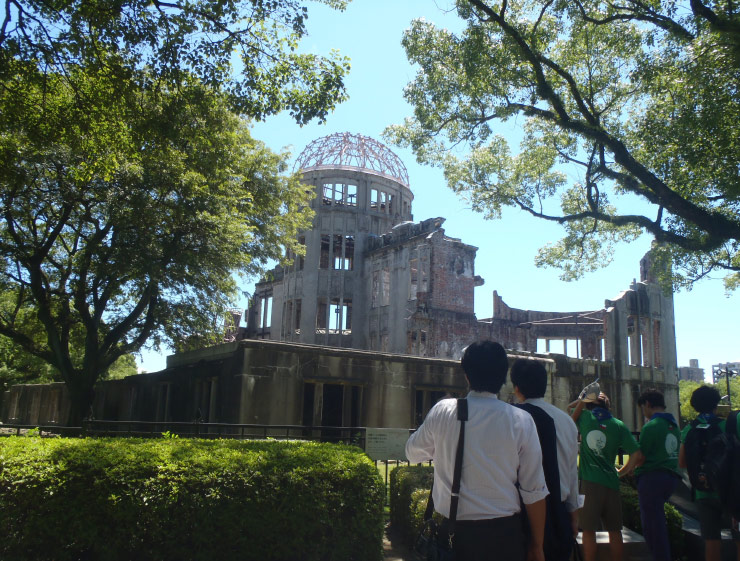
From the Peace Park, I went to Hiroshima Castle. While I was there, a random older Japanese bloke came up to me and starting speaking English, things like “where are you from?”, “do you like it here?” and so on. I decided to reply to him in Japanese to see what he would do, and we ended up talking to each other in the other’s language in a perfectly friendly manner. In my conversations with people throughout my time in Japan, I nearly always started speaking in Japanese. Most people replied in Japanese, but if I asked them to repeat themselves I found that they often switched to English instead. Obviously they thought my Japanese was the problem, rather than my hearing. I really wished that they would just repeat themselves, maybe slower this time, or simplify what they had said to me, but it was hard getting that idea across when they were trying to be helpful.
After my day of walking and viewing, I wanted to experience Hiroshima-style okonomiyaki – a Japanese savoury pancake. On my map, there was a place marked “Okonomiyaki Alley” so I went hunting. It was dark, the map wasn’t as precise as it could be, and I must’ve walked past the entrance to the building that the “alley” was in several times, looking for an actual street. It was pretty frustrating but I persevered and my reward was delicious okonomiyaki cooked in front of me, with baseball on the telly in the corner, and other customers smiling at me as we ate our food. It was a good atmosphere.
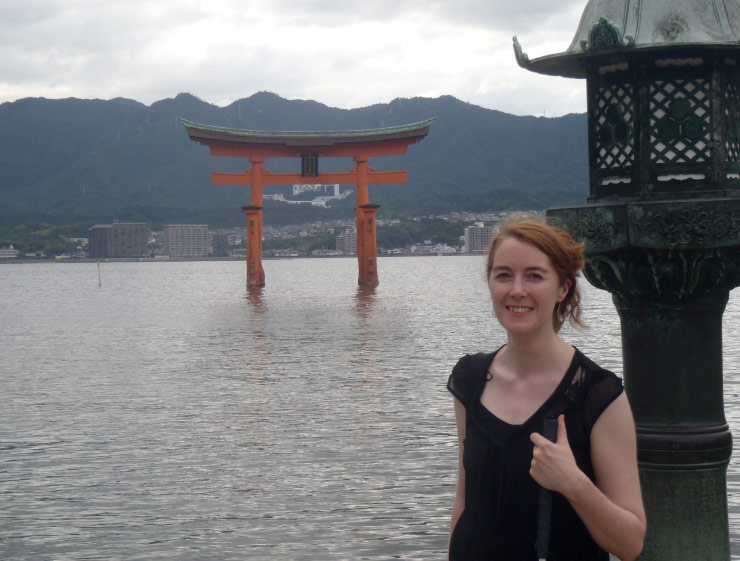
While I was in Hiroshima, I went to Miyajima on a day trip. The tram station was a little confusing, but the ticket woman pointed me to the right place, then when I was on the tram, the conductor made sure that I had a seat. He asked where I was going and, despite the background noise of the tram, I could understand him and reply. He made sure that I got off at the last stop, not before, which was kind of him. It was then that I realised that I was starting to be able to lipread in Japanese, which was a wonderful feeling.
At the top of Miyajima, at Mount Misen, I got caught up in an Osaka company trip. A man came over and asked me to take a photo of him and his friends, and explained how to use his camera. I don’t know what I was doing wrong but it took about five minutes for me to manage then we all cheered and they took another photo with me in it. We were all in the same cable car going back down, and the camera man asked me in English why I had a white cane. I said in English that I have very bad eyesight, but he didn’t understand so I switched to Japanese to explain and we ended up having a blether about their work, Brazil, and Scotland with dictionary apps to help. It makes me laugh to imagine him showing his holiday photos to people, saying “And here’s the blind woman who took a photo of us, I didn’t realise she was blind until later. Hmm, maybe that’s why she took so long to take the photo…”
Ooh, Look! I've Been Here Before (Kyoto)
If you go to Japan and get the chance to stay in a ryokan (a traditional Japanese inn), do it! I did, when I went back to Kyoto and I loved it. The owners and staff were really friendly and helped with bus timetables and advice, and the breakfasts were stupendous. If I could, I’d live in a ryokan.
This time in Kyoto, I was able to go to Fushimi Inari-taisha, the shrine with the red torii. After looking around the main shrine area, I decided to take the path up the hill through the thousands of torii. I’ve never been anywhere like it, surrounded by the red of the gates and the deep green of the trees and plants. Most of the time I was alone so I took my time and appreciated the environment. It was a hot, humid day though, and when I got to the top, what did I hear but the roll of thunder. At the top of a hill. With a metal cane in my hand. And no cafe to hide in. I made the descent rather rapidly, and got thoroughly drenched too. Just another adventure in the life of Julie.
You might be able to tell that I like visiting castles. I went to Nijoo Jo, partly to experience walking on a nightingale floor. I wasn’t sure if I’d be able to hear it, but I did hear a quiet chirruping sound every so often. While I was walking through the corridors, I slowly began to notice that no one else was looking up at the ceiling though. I thought this was odd because the high parts of the corridor walls and the ceiling had a lot of beautiful paintings and colours. Maybe it’s because I’m used to scanning the area around me constantly to use my limited vision better, but when I stopped and watched the other tourists, they were looking around but not up. It was a shame.
Maybe Tokyo's Not That Bad Afterall…
In Fukuoka, I had the chance to wear a yukata twice, and decided to buy one in Tokyo just before I came home. By the time I found a non-touristy looking place, I was sweltering so walking into the air con felt amazing. The shop owner was really friendly and let me look closely at some of the high-end kimono that she had on display. When I tried to comment on the embroidery in Japanese, she started to tell me about the different styles and patterns, the differences between traditional styles and more modern ones, and to teach me the names of the kimono parts in Japanese. I really enjoyed that, though the dictionary app came out and stayed out for the whole conversation. And yes, I bought a yukata; I got help with the yukata pattern and obi colour, since I’m pretty bad with shades and matching them.
I gave myself my toughest challenge on my last night in Tokyo. I hadn’t made it to an onsen, so I decided to find a public bath, a sentoo, near my hotel for one last Japanese experience. It took ages to track the place down because it was tucked in an alley, but I found it, got my tickets for a towel and a bath then went in. I had to take off my glasses, leave my white cane in the locker and take out my hearing aids. There were lots of women in there, though, and they helped me with using the taps and which bath to go into. When I was ready to soak some women came in with me and had a wee blether with me in Japanese as we relaxed in the hot water. It was difficult, but I explained that I was deaf and we managed with a lot of smiles. After, I sat by Sensoo Ji, drinking cold ume juice and admiring the lights, while plotting how soon I could come back. Tokyo might have grown on me…
What Difference Has Japan Made in My Life?
Japan taught me that yes I can speak Japanese understandably, and follow what others say to an extent. It also showed me how much more I have to learn. I already knew how much easier it is to progress in a language in the country where it’s spoken, but my speaking and listening improved more than I expected.
At my work, I’m now helping to co-ordinate Japanese language learning in my local council area, and my school has started a one-year course for senior students which I’m helping to teach. My Japanese friend who lives locally is a very important part of this project, and I’m enjoying working with her and the rest of the team. Due to a visit from a Japanese high school to my corner of Scotland, I was able to meet the Consul-General of Japan, and his deputy, who visited us from Edinburgh, and also the Depute Director of the Japan Foundation, which is based in London. I’ve even been interviewed for national radio, talking about my school’s new course and what it’s like to learn Japanese. Not bad for a science teacher!
But the biggest difference? After being registered blind, Japan restored my confidence in my ability to be independent.
I was deafblind in Japan, and I succeeded.

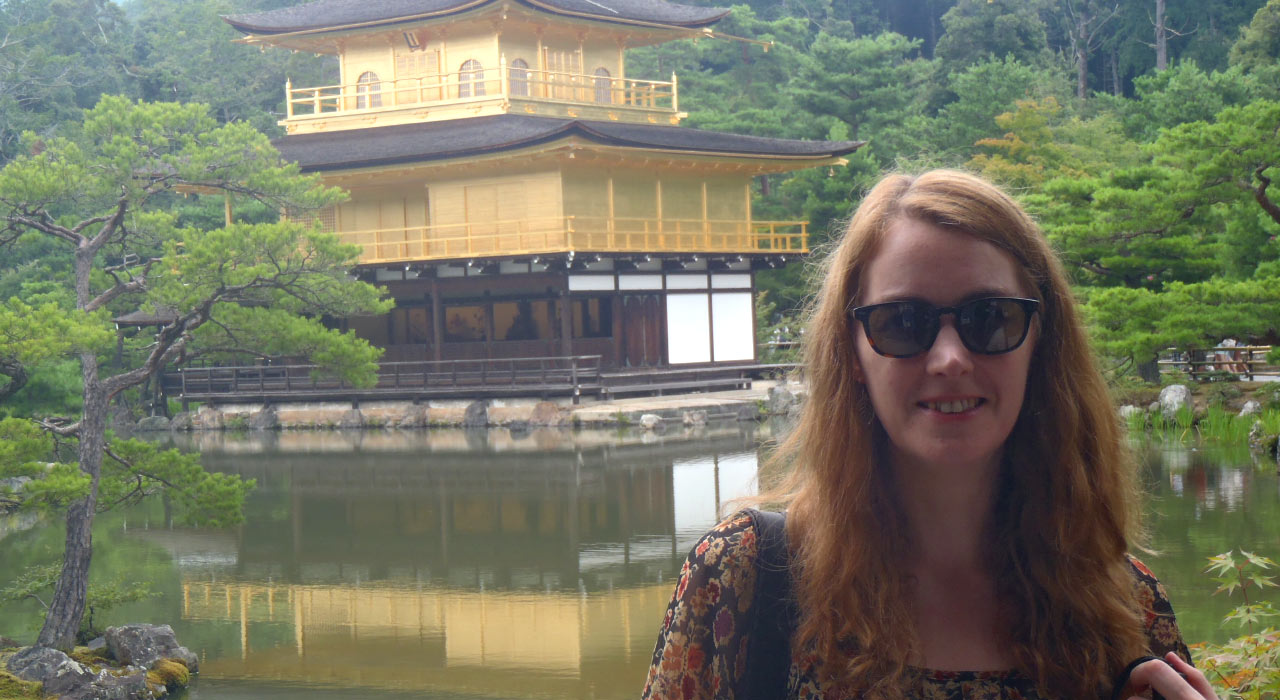

Social